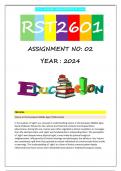LOLA JACOBS ASSIGNMENTS © 2024
RST2601
ASSIGNMENT NO: 02
YEAR : 2024
PREVIEW:
Visions in the European Middle Ages? (500 words)
In his analysis of 'sight' as a concept in understanding visions in the European Middle Ages,
David Chidester delves into the cultural and historical contexts that shaped these
phenomena. During this era, visions were often regarded as divine revelations or messages
from the spiritual realm, and 'sight' was fundamental in interpreting them. This perception
of 'sight' went beyond mere physical sight; it was linked to spiritual insight or
enlightenment. Influenced by Christian theology and philosophy, the ability to 'see' visions
was considered a gift from God, granted to certain individuals to communicate divine truths
or warnings. This understanding of 'sight' as a form of divine communication deeply
influenced how these visions were interpreted and valued in medieval European society.
, LOLA JACOBS ASSIGNMENTS © 2024
PORTFOLIO ASSESSMENT
This is the portfolio as non-venue based examination that counts for 60% of the final
mark.
The portfolio is based on SECTION B: SENSES and SECTION C: TECHNOLOGY, as well as the
CONCLUSION of the learning units.
1. SENSES
This part of the portfolio is based on SECTION B: SENSES.
1.1 Vision (1000 words; 20 marks)
The purpose of this part of the portfolio is to test whether you have achieved the outcomes
of study unit 5.
How does Chidester use ‘sight’ as a concept to analyse
1.1.1 visions in the European Middle Ages? (500 words)
In his analysis of 'sight' as a concept in understanding visions in the European Middle Ages,
David Chidester delves into the cultural and historical contexts that shaped these
phenomena. During this era, visions were often regarded as divine revelations or messages
from the spiritual realm, and 'sight' was fundamental in interpreting them. This perception
of 'sight' went beyond mere physical sight; it was linked to spiritual insight or
enlightenment. Influenced by Christian theology and philosophy, the ability to 'see' visions
was considered a gift from God, granted to certain individuals to communicate divine truths
or warnings. This understanding of 'sight' as a form of divine communication deeply
influenced how these visions were interpreted and valued in medieval European society.
In contrast, the AmaZulu's religious tradition views dreams as a vital aspect of spiritual
communication. Dreams are seen as a means through which ancestors communicate with
the living, offering guidance, warnings, or blessings. Here, 'sight' encompasses a broader
understanding of perception that includes dreams, visions, and spiritual insight. Chidester's
analysis underscores the cultural specificity of these concepts of 'sight' and how they reflect
broader beliefs and values within their respective societies. By examining 'sight' in different
cultural and religious contexts, Chidester offers insights into the diversity of human
experience and how culture shapes our understanding of the world.
, LOLA JACOBS ASSIGNMENTS © 2024
Chidester's approach to 'sight' as a metaphorical tool extends beyond the conventional
senses, encompassing metaphorical uses in religious discourse, the visions and dreams of
mystics and shamans, and new media as extensions of human senses. His analysis of visions
in the European Middle Ages is deeply rooted in the context of that time, where visions
played a significant role in religious experiences, interpreted as divine revelations or
prophetic insights. Chidester's exploration sheds light on how these visions were used to
communicate religious ideas, influence social norms, and shape political landscapes,
highlighting the importance of 'sight' in shaping religious thought and practice during the
Middle Ages.
Similarly, in the religious tradition of the AmaZulu, Chidester explores the role of dreams,
citing the work of Henry Callaway's "Religious System of the Amazulu" (1868–1870). Dreams
are integral to their religious tradition, serving as a bridge between the physical and spiritual
realms. Chidester's analysis provides a rich understanding of how dreams, as a form of
'sight', play a crucial role in the AmaZulu's religious practices, where ancestors appear in
dreams and offerings and sacrifices are common means of connecting with the gods.
In both contexts, Chidester's use of 'sight' as an analytical tool offers a unique perspective
on the role of sensory experiences in religious phenomena, providing a deeper
understanding of the complex interplay between religion, culture, and human experience.
• Symbolism and Interpretation: Chidester could explore how visions were often highly
symbolic in nature and required interpretation. The interpretation of visions was a
complex process that involved understanding the cultural and religious symbols of
the time. Visionaries and mystics often relied on religious texts and teachings to
interpret the meaning of their visions, highlighting the importance of religious
knowledge and authority in understanding divine communication.
• Social and Political Context: Chidester could discuss how visions were not only seen
as spiritual experiences but also had social and political implications. Visions could
be used to legitimize authority, inspire social change, or justify political actions. The
interpretation of visions could vary depending on the social and political context,
highlighting the dynamic nature of visionaries' roles in medieval European society.
• Gender and Visions: Chidester could also explore how gender influenced the
experience and interpretation of visions. In medieval Europe, women were often
more likely to be associated with visionary experiences, and their visions were
sometimes viewed with suspicion or skepticism. Understanding how gender roles
shaped the perception and interpretation of visions could provide further insight
into the cultural dynamics of the time.
• Visionaries and Authority: Chidester could discuss the role of visionaries as
mediators between the divine and the human realm. Visionaries often gained
significant authority within their communities, and their visions were seen as
authoritative sources of religious knowledge. Understanding how visionaries were
perceived and the authority they wielded could provide a deeper understanding of
the role of visions in shaping medieval European society.




